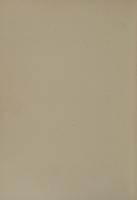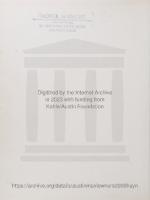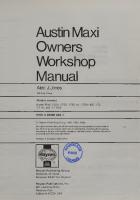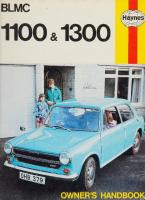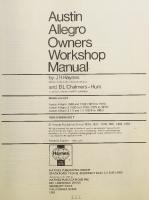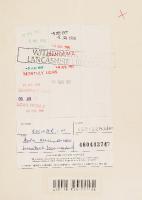Haynes Austin Maxi Owner's Handbook and Servicing Guide 0856963909, 9780856963902
Austin Maxi, all UK models from 1969-1500, 1750 and 1750 HL: owners handbook/servicing guide.
185 28 8MB
English Pages 120 Year 1979
Recommend Papers
File loading please wait...
Citation preview
ax
oe
=~ ‘
i ~ LIVE
IN-LINE CHOKE (SEE TEXT)
0.2 5uf—O. 5uf
VE) EUS TO IGNITION SWITCH
TO DISTRIBUTOR
TO CONTACT
SWITCH" 9367 (IF FITTED)
MOTOR
The correct way to suppress electric motors which are causing interference
BREAKER
LARGE TERMINAL
BOLT DOWN TO EARTH (CLEAN WELL FIRST)
HEAVY WIRE THIN WIRE
The correct way to connect a capacitor to the coil
(above) and the generator (right) TERMINAL
Ignition HT lead suppressors Left: Resistive suppressor-type plug caps.
SCREW IN FOR HT LEAD
Right:
INTERNAL RESISTOR
Resistive in-line suppressors
TWIN SCREW -IN
THE PERSONAL TOUCH possible for a driver wearing a seat belt to reach the unit in order to change or turn over tapes.
Visibility aids
bare metal edges. When the primer’s dry you can fit the mirror following the maker's instructions, then angle it as necessary to get the best rear view.
Rear window demisters
Mirrors Recent EEC legislation has done wonders for the looks of exterior mirrors. In addition to being functional, they now must have no projections to catch clothing or other cars, and must fold flat when struck. The result is a new wave of products in all shapes and sizes, some of which can be sprayed to match up with the existing car finish. There has also been a marked swing recently from wing mirrors to the door-mounting kind. Choose mirrors which you think will suit the car’s styling and, having got them, select the mounting point carefully. You'll get a good idea of where the best place is by simply looking at other cars, but get someone to hold the mirror while you sit in the driving seat just to make sure you can see all you need to.
Mark the position on the wing or door, and if you're fitting two mirrors do likewise on the other to make sure they're both in the same position. Check the hole size needed and, if you can, select a drill this size, plus, where applicable, a smaller one to make a pilot hole. If you haven't got the large drill required for most wing mirrors, you'll have to drill several small holes and file them out to the correct size. Don't forget to remove any burrs from the hole afterwards, then paint on a little primer to cover the
MAG
‘European’
At one time, if your car wasn’t fitted with a heated rear window as standard equipment (and only the expensive models were) about the only remedy
was a Stick-on clear panel designed to act a bit like double glazing. They didn't usually work very well and frequently came unstuck too. Now they've been more or less superseded
by the element
type of stick-on
demister. These act more like the genuine article, consisting of a metal foil element which is peeled off a backing sheet and stuck onto the inside surface of the rear window glass. It has to be wired up to the electrical system, of course, via a suitable fuse and switch, using sufficiently heavy cable and preferably incorporating a warning lamp as it will take quite a large current and shouldn't be left on inadvertently. The great thing about these devices is that they do work and are very moderately priced.
Rear window wipe/wash This can be very useful where it’s found that the back window regularly becomes obscured by road dirt from the car's slipstream in wet weather. Fitting may be found to be beyond the scope of the ordinary car owner because the wiper motor has to be fitted into the inside skin of the tailgate. The wiring and washer tubing, too, is slightly complicated by having to be passed through the whole length of
door mirror
THE PERSONAL TOUCH the body from the switch/reservoir before being led through into the tailgate. Again, full instructions will be supplied by the makers.
Headlamp conversions Stil!
on
the
subject
expenditure worthwhile. Get other advice, preferably from someone who's fitted such a system to his own car. Consider too whether you're capable of installing it yourself, otherwise you'll have to pay for fitting as well.
of better
visibility,
if your
There
are several types of electronic
ignition —
problem's seeing in the dark, then you might well consider uprating your car's headlamps. A number of conversions are available for the standard British 7inch units fitted to the Maxi models and mostly they're fitted by simply interchanging with the old ones, no wiring modifications being needed (see /n an Emergency for headlight removal).
some retain the conventional contact-breaker in the car's distributor while others replace this by a magnetic triggering device. Even where the contact points are retained they're no longer likely to burn and therefore shouldn't need replacing so frequently — but this doesn’t in itself amount to much of a saving.
Comfort
One of the more popular, easily fitted accessories is a special steering wheel. Many types are available, but often it’s also necessary to buy a boss which fits on to the steering column shaft, to which the steering wheel is then attached. No problems should be encountered when fitting a steering wheel or boss, once the old steering wheel has been taken off. The procedure below tells you how to remove the standard wheel from the different models covered by this book. On all models carefully lever out the motif or safety pad. Using a suitable socket, unscrew the central nut and remove the washer. Mark the position
Longer journeys can be much more pleasant if your car's comfortable to drive, and just a couple of suggestions on this theme may be welcome.
Sound reducing kits Very few cars have yet been produced in which the noise level, particularly at motorway speeds, is all that could be desired. For economy reasons, most manufacturers put only a certain amount of underfelt and sound-deadening material into their cars, and a further improvement can usually be made by fitting one of the proprietary kits. These are usually tailored to fit individual models, and consist of sections of felt-like material which are glued in place under carpets, inside hollow sections, boot lid etc, in accordance with instructions. The material can also be bought in rolls for D-I-Y cutting, using the carpets etc as templates.
Seats If your car seats are showing signs of old age (and just fitting new covers won't disguise the sagging when you sit in them) then you can of course have them rebuilt by an upholstery specialist. On the other hand, if you want to improve on the original seats anyway, you could think about replacing at least the driver's seat by one of the special bucket types available. To look at these you'll have to find an accessory shop stocking the more motor sport
orientated kind of goods.
Miscellaneous Electronic ignition Such systems are many and varied and widely advertised. The makers claim easier starting, better performance and lower fuel consumption as the main advantages, and on the whole these claims are substantiated in practice. However, before buying one of the available kits we suggest you stop and reflect whether your mileage and type of driving makes the
Steering wheels
of the hub with respect to the steering column shaft, then pull off the steering wheel. Refitting of the replacement steering wheel must now be in accordance with the manufacturer's instructions. Use the mark made on the old steering wheel to provide a guide for fitting the replacement in the correct position so that it’s centralised when the
front wheels are pointing straight ahead.
Roof racks Although the Maxi has a reasonable amount of luggage space, awkward loads and extra holiday luggage are usually best carried on a roof rack. The types available are very varied, but they normally rely
on clips attached to the water drain channel above the doors. If you’re buying, select a size that suits your requirements, making sure that it’s not too wide for the roof! When fitting the roof rack, position it squarely on the roof, preferably towards the front rather than the rear. After it’s loaded, by the way, recheck the tension of the attachment bracket screws. Don't keep the roof rack on when it’s not wanted; it offers too much wind resistance and creates a surprising amount of noise (see Save /t/).
Dog/luggage guards Owners who carry a dog or large loads in the rear of the vehicle will no doubt find one of these tubular
| \ ‘\ Desmo’s ingenious ‘Accordion’ roof rack folds up to fit in the boot when not in use
THE PERSONAL TOUCH
MAG Universal dog/luggage guard barriers beneficial. They’re normally adjustable telescopically both for height and width, and are fitted by clamping between roof and load deck immediately behind the rear seat to keep dog, luggage or whatever in its rightful place and possibly prevent injury to the front seat occupants in an emergency stop.
Mudflaps You're probably already aware that both front and rear wheel arches can be fitted with mudflaps. These will not only protect you car's underside and paintwork from flying stones, but will also earn the thanks of following drivers owing to the reduction in spray during wet weather. Fitting’s straightforward
90
and is usually by means of clamping brackets or selftapping screws.
Specialist fitments We've now covered a lot of main items likely to interest the average owner from the D-I-Y fitting angle. Such things as towbars and sunshine or vinyl roofs, while practical or desirable, are beyond the scope both of this book and of the ordinary car owner. We* therefore recommend that for any major accessory of this kind you consult the appropriate specialist who'll be able to give you an initial estimate of the cost as well as carrying out the work properly and safely.
Troubleshooting We've gone to great lengths in this book to provide as much information on your car as we think you'll need for satisfactory running and servicing. Hopefully, you won't need to use this Chapter but there’s always a possibility (rather than a probability!) that something will go wrong, and by reference to the charts which follow you should be able to pinpoint the trouble even if you can’t actually fix it yourself. The charts are broken down into the main systems of the car and, where there's a fairly straightforward remedy — the sort you can tackle yourself — bold type is used to highlight it. Further information on that particular item will normally be found elsewhere in the book; look up the component or system in the Index to find the correct page. In some cases a reference number will be found (e.g. T1/1); by looking up this number in the accompanying Crossreference Table, you'll find more information on that particular fault.
91
TROUBLESHOOTER Starter motor doesn’t work when key is turned
Flat battery (T1/1) Battery connections loose or corroded Loose connection to starter (T1/2) Automatic transmission
1:
Starter motor doesn’t work properly
Starter motor or solenoid switch faulty internally
Doesn't turn engine
§ selector
Starter pinion sticking jammed in mesh with
not at ‘N’.
flywheel (T1/3).
Turns engine very slowly
Battery flat (T1/1) or defective Internal starter motor fault
Spark plug lead(s) loose, disconnected, damp or faulty (T1/4) Spark plugs dirty, cracked or incorrectly gapped. Distributor or coil cap damp, cracked or HT lead loose. Worn distributor cap electrodes. Coil or condenser
faulty (T1/5) Contact breaker points dirty or incorrectly set.
Ignition timing incorrect.
ENGINE — STARTING Starter motor turns engine normally but engine won't start
faa Works noisily or harshly
Ignition system
Fuel system fault
Other causes
Pinion or flywheel teeth broken or
worn. Air cleaner blocked. Valve clearances incorrect. Inlet manifold or gasket or carburettor gasket leaking. Brake servo hose
Starter drive main spring broken. Starter motor retaining bolts loose (T1/7).
leaking (T1/8). Engine seriously overheated
(T1/9).
Fuel pump faulty or filter blocked (71/6). Leak in fuel pump or fuel lines. Carburettor float chamber fuel
level(s) incorrect. Carburettor incorrectly
adjusted. Choke not operating correctly.
93
TROUBLESHOOTER
2:
Lacks power
Ignition fault Timing incorrect
Fuel system fault
Other causes
Running too cool. Incorrect valve
Incorrect thermostat installed. Thermostat missing or not working
clearances. Low cylinder compression. Air cleaner
properly.
blocked.
Overheating
Insufficient water in cooling
system/leakage from system
(T2/1). Drive belt slipping.
Radiator blocked or grille obstructed (T2/2). Water hose collapsed or
kinked (T2/3). Thermostat not operating properly. Exhaust system obstructed or damaged. Blown cylinder
head gasket. Engine not yet runin (72/4). Brakes binding (over-adjusted). Oil level too low.
ENGINE — RUNNING
le Misfires
Ignition fault.
Fuel system fault.
Cuts out unexpectedly
Ignition fault
Fuel system fault
Water on ignition
Tank empty. Fuel pump faulty
components (71/4). Coil or condenser faulty (T1/5). LT lead to coil or distributor disconnected (T1/4). HT lead from coil loose or discon-
nected (11/4).
Spark plug lead(s) loose, disconnected, damp or faulty (T1/4). Spark plugs dirty, cracked or incorrectly gapped. Distributor or coil cap damp, cracked
or HT lead loose. Worn distributor cap electrodes. Coil or condenser faulty (T1/5). Contact breaker points dirty or incorrectly set. Ignition timing incorrect.
Fuel pump faulty. Leak in fuel pump or fuel lines. Carburettor jet(s) blocked. Carburettor float chamber fuel
level(s) incorrect. Carburettor incorrectly adjusted. Choke not operating correctly.
(71/6). Fuel line broken, leaking or blocked.
TROUBLESHOOTER
Gearchange problems
Judder/vibration
On letting in clutch
3:
eel Difficulty inengag-
When running
|§ Jumping out of gear
ing or changing
gear
Gearchange selector mechanism worn or damaged.
Engine/transmission mountings loose or perished.
Clutch friction surfaces badly worn or oily. Release mechanism worn.
Steering or suspension fault
(Troubleshooter 5).
Drive shaft constant velocity joints worn.
Synchromesh mechanism worn or damaged. Air in clutch hydraulic system.
CLUTCH & TRANSMISSION Irregular noises
ae: 1 ee From clutch
On depressing
From gearbox
On releasing pedal
Whining or grinding
pedal
Release mechanism dry, worn or damaged.
From drive shafts
noise while running
Clutch driven plate distorted.
Pedal pivot or clutch cable requires lubrica-
Incorrect grade of oil in use, or low level.
Gear teeth or shaft bearings badly worn or damaged.
tion.
Crunching noises
ue
when changing
gear
97
TROUBLESHOOTER
4:
Pedal operation
Excessive pedal travel
Fluid level too low. Rear brake needs adjusting.
‘Spongy’ feel
Leaks in system Wheel cylinder or caliper leaking. Master cylinder leaking. Brake line or hose leaking.
‘Springy’ feel or high pedal pressure needed Air in system (requires bleeding).
New linings/pads not yet bedded in. Drums/discs badly scored or distorted. Master cylinder bolts loose. Brake servo faulty or hose loose or
damaged (T4/1).
TROUBLESHOOTER Steering feels light and vague
Steering wheel has
i
5:
Steering feels stiff and heavy
me|
Tyres
Suspension
Steering balljoints
Tyre pressures too
Pressures too
geometry wrong.
badly worn.
low or uneven.
high.
Subframe distorted
Steering gear needs
Steering swivels
adjusting.
need greasing. Suspension
Wrong type
geometry wrong. Steering gear incorrectly adjusted. Steering column badly distorted.
BRAKES Effect on car
Car pulls to one side
Drums/linings or pads/discs con-
Brakes ‘grab’ or
Brakes bind when
wheel(s) lock
pedal released
Contamination by oil, grease or fluid.
Rear brakes/handbrake overadjusted. Master cylinder pushrod out of
taminated with oil, grease or fluid. Brake backplate, caliper or disc loose. Shoes or pads incorrectly fitted. Differing types of linings fitted at each side. Suspension anchorages loose.
adjustment.
Vent hole in reservoir cap blocked. Master cylinder or wheel cylinder seized.
Drums/discs badly worn or distorted. Tyre pressures unequal.
STEERING/SUSPENSION Wobble/vibration from front wheels
Loose wheelnuts. Damaged wheel.
Wheels/tyres need balancing. Suspension balljoints worn.
Car settles too low or leans to one side while stationary
Loss of pressure in suspension system
Car leans over excessively when cornering
Rear anti-roll bar or auxiliary springs defective or mountings loose.
99
TROUBLESHOOTER
6:
A fault occurring in any other electrical equipment or accessory not specifically referred to can usually be traced to one of three main causes, i.e. blown fuse; loose or broken connection to power supply or earth; or internal fault in the component concerned.
Fuel gauge
Gauge
gives
no
reading
Horn
Registers ‘full’ all
Operates all the
the time
time
Doesn't work
Cable between tank unit and gauge broken or disconCable between tank unit and gauge earthed. Voltage stabilisers faulty.
nected.
Horn push earthed or stuck down. Cable from horn to horn push earthed.
NOTE: This chart assumes that the battery installed in your car is in good condition and is of the correct specification, and that the terminal connections are clean and tight. A car used frequently for stop-start motoring or for short journeys (particularly in winter when lights, heater blower etc are likely to be in use) may need its battery recharged at intervals to keep it serviceable. If an electrical problem occurs, don’t immediately suspect the starter or any other component without first checking that the battery is capable of supplying its demands!
100
ELECTRICS
Lights
Don't come on
OR
Come on but go out again
Work erratically or flicker on and off.
Battery flat (T1/1). Bulb or filament
Lamps not earthing properly
broken.
(T6/1).
Give very illumination.
poor
Light switch faulty.
Cable or connec-
Light switch faulty.
Bulbs or lenses
tion corroded, loose, broken or
dirty or reflectors dirty or corroded.
disconnected.
Wrong bulbs installed.
101
TROUBLESHOOTING
CROSS REFERENCE TABLE
TROUBLESHOOTER REFERENCE
T1/1
Either
charge
ADDITIONAL INFORMATION
the
battery
from
a battery
charger, or use jump leads to start the car from another battery, make sure that the lead polarities are correct in both cases, or you may do permanent damage, particularly to your alternator.
T1/2
T1/3
T1/4
TROUBLESHOOTER REFERENCE
T1/8
For a temporary repair a leaking hose can normally be bound up with adhesive tape or, better still, with a hose bandage available for this purpose.
T1/9
Wait till the system's cooled down, then top it up. If it happens a second time, get it looked at straight away or you could ruin
If the lead’s loose, disconnect the battery earth lead then tighten the connection on the starter motor; make sure the bolt doesn't turn while you're tightening the nut. Reconnect the battery earth lead. You can use a spanner on the square-ended shaft on the end of the starter motor. By turning it you'll normally be able to free it from the flywheel ring gear.
ADDITIONAL INFORMATION
your engine (if it hasn't happened already). If it’s just a leaking hose you can probably bind it up as in T1/8 (above) to get yourself home.
T2/1
See T1/9
T2/2
Driving carefully will probably An airline on the radiator core the dirt that’s accumulated; internally use a proprietary pound.
Make sure that all the connections are tight, then wipe the leads clean and dry with a lint-free cloth. Use an ignition system
get you home. will clean out if it’s blocked flushing com-
waterproofer (e.g. WD40 or Damp Start) to prevent problems in the future.
T2/3
You
may
be
temporarily T1/5
T1/6
An ignition coil is a simple item to fit, but make a note of the connections before removing them, and ensure that the replacement coil’s the correct type. Renewal of the condenser is covered in the 24000 mile Service Schedule. To check the operation of the pump, detach
102
It's easy enough to tighten the attachment bolts if you've got a box or socket spanner of the right size; if you haven't, it’s not really a
D-I-Y job.
repair
but
the
it'll
hose
almost
T2/4
Drive more the engine.
T4/1
Provided there’s no loss of hydraulic fluid, you'll need a little extra pedal effort for braking but that’s all. It may be possible to temporarily repair the hose as in T1/8.
T6/1
Remove
slowly — but without labouring
the
Emergency)
T1/7
to
11/8)
certainly mean a new one.
the fuel outlet pipe (that’s the one that goes to the carburettor and turn the engine over on the starter a few times. There should be a steady stream of petrol if the pump’s working properly.
able
(see
lamp
and
lenses
check
(see
/n An
for signs of rust.
Where there's rust, scrape it off and apply a little Vaseline. Ensure that the screws securing the lamp body to the car are making good contact.
103
Ajay!7
Bunsns sjulod UO ay}
Ixey/
S/apow
CONVERSION Distance Inches (in) Feet (ft) Miles
Millimetres (mm) Metres (m) Kilometres (km)
Capacity Inches, cubic (cu in/in3) Fluid ounce, imperial (fl oz) Fluid ounce, US (fl oz) Pints, imperial (imp pt) Quarts, imperial (imp qt) Quarts, imperial (imp qt) Quarts, US (US qt) Quarts, US (US qt) Gallons, imperial (imp ga!) Gallons, imperial (imp gal)
Gallons, US (US gai) Gallons, US (US gal)
Centimetres, cubic (cc/cm3) Centimetres, cubic (cc/cm3)
Centimeters, cubic (cc/cm3) Litres Litres Litres Litres Litres Litres Litres
(L) (L) (L) (L) (L) (L) (L)
Millimetres (mm) Metres (m)
25.400 0.305 1.609 0.039 3.281 OX x& 0.621
16.387 35.51 29.57 0.568 1.1365 1.201 0.9463 0.8326 4.546 1.201 3.7853 0.8326 0.061 0.02816 0.03381 28.16 33.81 1.760 0.8799 1.0567 0.220 KOK O&K OK KO KKK 0.264
Kilometres (km) Inches (in) Feet (ft) Miles
Centimetres, cubic (cc/em?) Centimetres, cubic (cc/em?) Centimetres, cubic (cc/em?)
uou
Litres (L) Litres (L) Quart, US (US qt) Litres (L) Quarts, imperial (imp qt) Litres (L) Gallons, US (US gal)
Litres (L) Gallons, imperial (imp gal) Inches, cubic (cu in/in3) Fluid ounces, imperial (fl oz)
Fluid ounces, US (fl oz) Fluid ounces, imperial (fl oz) Fluid ounces, US (fl oz)
Pints, imperial (imp pt) Quarts, imperial (imp gt) Quarts, US (US qt) Gallons, imperial (imp gal) Gallons, US (US gal)
Area Inches, square (in2/sq in) Feet,square (ft2/sq ft)
Millimetres, square (mm2/
645.160
Millimetres, square (mm2/
0.093 0.002
sq mm) Metres, square (m2/sq m) Inches, square (in2/sq in)
sq mm)
Metres, square (m2/sq m)
os 10.764 ae OS Xu
i]
Feet square (ft2/q ft)
i]
Grammes (g) Kilogrammes (kg) Ounces (oz) Pounds (Ibs) Ounces (oz)
Weight Ounces (oz) Pounds (Ibs)
Grammes (q) Kilogrammes (kg) Kilogrammes (kg)
104
28.350 0.454 0.035 2.205 *« XK KX & 35.274
FACTORS Pressure Poundsfgq in (psi/lb/sq in/
X
0.070
=
Kilogrammes/sq cm
Pounds/sq in (psi/lb/sq in/
X
0.068
=
Atmospheres (atm)
Ibfin2) Kilogrammes sq cm (kg4&qem)
xX
14.223
=
Poundsfg in (psilb/sq in/
Atmospheres (atm)
X
14.696
=
Pounds in (psilb/q in/ Ib/in2)
Pound - inches (Ibf in)
X
0.0115
=
Kilogramme - metres
Pound - inches (Ibf in) Pound - feet (Ibf ft) Pound - feet (/bf ft)
X 0.0833 2. X 0.138
= = =
Pound - feet (Ibf ft)
X
=
Pound - feet (Ilbf ft) Pound - inches (Ibf in) Kilogramme - metres (kgf m) Newton - metres (Nm)
Kilogramme -~ metres (kgf m) Kilogramme - metres (kgf m)
X 86.796 D6 Pp ARES}
= =
Pound - inches (Ibf in) Pound - feet (/bf ft)
Newton
X. 0.738
=
Pound - feet (/bf ft)
X
=
Kilogramme - metres
Ib /in2)
(kg/sq cm)
Ib /in2)
Torque (kgf m)
- metres (Nm)
Newton - metres (Nm)
1.356
0.102
(kgf m)
Speed Miles - hour (mph)
X
1.609
=
Kilometres - hour (kph)
Feet - second
X
0.305
=
Metres - second (m4)
Kilometres - hour (kph) Metres - second (mf) Metres - second (m/s)
X X X
0.621 3.281 3.600
= = =
Miles - hour (mph) Feet - second Kilometres - hour (kph)
X X
0.354 2.825
= =
Kilometres - litre (km/) Miles - gallon, imperial
Consumption Miles - gallon, imperial (mpg) Kilometres - litre (km/)
(mpg)
Temperature Centigrade (°C) to Fahrenheit (°F)
9 —
9C+32=9F
By
Fahrenheit (°F) to Centigrade (°C)
5
105
Index
Accessory shops 33 Adjustments — carburettor 57 contact breaker points 54
fan belt 53 headlight beam alignment 27, 51 rear brakes 51 spark plugs 57 valve clearances 53
Air cleaner — element renewal 63 summer/winter setting 71 Ammeter 81 Antifreeze renewal 68 Anti-theft devices 84 Automatic transmission — control techniques 15 general information 14 parking pawl engagement check 63 specifications 39 towing with 15
Battery — buying 31 condition indicator 81 electrolyte level check 49 specific gravity check 62 Body number 34 Bodywork — dents repair 74
filling 75 maintenance 71, 73 paintwork renovation 74 rust repair 75
spraying 75 Brake failure warning light 10, 29
Brakes — adjusting rear 51 disc pads 61
faults 98/99 fluid renewal 68 fluid reservoir level check 50 relining rear 64 servo filter element renewal 69 specifications 40
Carburettor — adjustment 57 damper, oil top-up 50 specifications 37 Car number 34
Carpets 73 Child safety seats 84 Cleaning — bodywork 74 interior 73 underside 69 Clock 81 Clutch — clearance check 67
faults 96/97
INDEX fluid reservoir level check 50 specifications 39 Comfort 88 Commission number 34 Consoles 82 Contact breaker points 55
Conversion factors 104/5 Coolant level checking 18, 49 Cooling system specifications 37 Crankcase ventilation air filter renewal 64
D Dimensions, general 41
Direction indicator warning light 10 Distributor — adjustments 54
maintenance 54 Dog/luggage guards 88 Doors, locks and hinges lubrication 51 Drive shafts — constant velocity joints rubber gaiters check 51 faults 97
Driving habits 32 Dwell angle meter 44
Fault finding —
brakes 98/99
clutch 96/97 electrics engine — engine — steering
100/101 running 94/95 starting 92/93 98/99
suspension 98/99 transmission 96/97 Firing order 35 Fog lights 81, 84 Fuel — buying 31 consumption 9 octane rating 20 Fuel gauge faults 100 Fuel system — faults 93-95 specifications 37 Fuel pump, filter cleaning 57 Fuel tank capacity 20 Fuses — changing 25 location 40 type 40
Dynamo lubrication 62
G
E Electrical system specifications 40
Gearchange problems 96
Electronic ignition 88 Engine — cubic capacity 35 cuts out unexpectedly 95 lacks power 94 misfires 95 number 34 overheating 94 running too cool 94 specifications 35 tuning 31 Engine oil — changing 52 checking level of 47 topping up 18, 47 type 20 Exhaust system — buying 31 maintenance 62
H Hazard warning 83 Headlights — beam alignment adjustment 27, 51
bulbs/units renewal 25 conversions 88 main beam flasher switch 13 main beam warning light 10 Horn faults 100 Horns, air 83 Hub bearings, checking for wear 66
Ignition Ignition, Ignition Ignition
circuits 72 electronic 88 switch/steering column lock 13 system —
faults 93/95 Fan belt — temporary 21 tension 53
specifications 37
Ignition timing 37 Ignition warning light 10
107
INDEX
Indicator/headlight main beam flasher switch 13 Instruments, auxiliary 79
Models history 7 Motor factors 33
Insurance 33 Interior light 29 Number plate light 27
Jacking up 22
Oil filter, changing 52 Oil pressure gauge 82 Oil pressure warning light 10 Overheating 94
Lights — auxiliary 81 bulb specifications 41
P
checking 49 faults 101 Panel light 29
fog 81 fog (rear) 84 spot 81 warning 10, 29 Lights, bulb renewal —
R
brake failure warning 29 headlights 25 interior 29 number plate and reversing 27 panel and warning 29 side and front flasher 27
stop/tail and rear flasher 27 switch panel warning 29 Lubricants, buying 31 Lubrication — carburettor 50 door locks and hinges 51 dynamo 62 Lubrication chart 48
M Maintenance — automatic transmission 63 battery 49, 62 bodywork 71, 73
brakes 51,61, 64, 68, 69 carburettor 63 clutch 67 distributor 54
exhaust system 62 fuel pump 57 spark plugs 57 steering 51,62, 66 suspension 62, 66
Mirrors 87
108 Misfiring 95
Radios — fitting 85 interference suppression 85, 86 Rear window demisters 87
Rear window wipe/wash 87 Repairs kit 21 Reversing light 27 Road test data 9 Roof racks 32, 88
Rust 75, 103
Seats — cleaning 73 renewal 88
Self-service garages 19 Service schedules —
250 miles/weekly 47 3000 miles/3 months 50 6000 miles/6 months 52 12 000 miles/12 months 63 24 000 miles/2 years 68 36 000 miles/3 years 69 Spring 69 Autumn 71
Servicing — road test after 52, 63 safety 46 seasonal 69 Side and front flasher lights 27 Sound reducing kits 88
INDEX
Spare parts, buying 33
Troubleshooting 91
Spares kit 21 Spark plugs — maintenance 57 renewal 64 specifications 37 Spot lights 81
Tyre pressures — checking 19, 47 recommended 20 Tyres —
Starter motor faults 92/93
buying 30 ‘instant’ puncture repair 21 sizes 20, 40
Steering — faults 98/99
U
maintenance 62, 66
specifications 39 Steering rack, rubber gaiters check 51 Steering wheels 88
Upholstery repairs 73
Stop/tail and rear flasher lights 27 Stroboscopic timing light 44
V
Suspension —
faults 98/99 maintenance 62, 66
specifications 40 Switch panel warning lights 29 Switches 13
Tachometer 82 Tailgate 17 Tape players 85 Tools — basic kit 42 care of 44 supplementary kit 43 Towing and being towed 23 Towing, with automatic transmission 15 Transmission (manual) specifications 39
Vacuum gauge 82 Valve clearances — checking 53 specifications 35 Vehicle identification numbers 33 Visibility aids 87
Warning devices 83 Warning lights 10, 29 Weights 41 Wheel changing 22 Wheel nuts, tightness check 50 Wheels — interchanging 63 size and type 40 Windscreen, temporary 22
109
:
ae
| ’
ers ‘ 3
Printed
Haynes Sparkford
by
Publishing Group Yeovil Somerset England
—
= -
— yee
Owner's Handbook/Servicing Guide All Austin Maxi models from 1969 with UK specification, 1500 (1485 cc) and 1750 (1748 cc) including 1750 HL and Automatic versions.
i
This new Handbook series is written for the owner who wants to get the best out of his or tescar in” terms of both motoring pleasure and economical running. It’s a time and cost saver, and a problem solver. We tell you how to reduce garage bills, and keep your car safe and roadworthy, by doing your own y routine
maintenance and servicing. Body repairs and interior and exterior renovation are covered in some — ptti Katype
detail. Y There are tips on saving money in other ways, too — on replacement parts, for example; and some ideas.si on fitting worthwhile accessories.. Emergencies like punctures are covered, of course, while in the vent:
of a mechanical breakdown the Troubleshooter Charts should help toget you out of trouble. Carry this book in your car at all times, and it should |save you itsmodest cost ery times over.
0 85696 390 9
a Pa
am N DOo
— — ee — —— = ——s — — =a ——— a a
=
— —— —e
cmp
—=
©
=
a ——— ore —— === —
